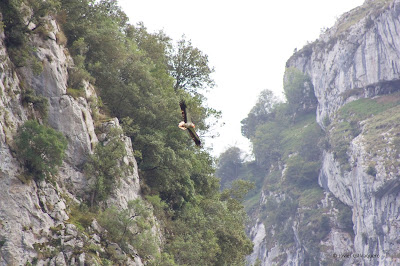The Griffon Vulture Gyps
fulvus, is one of the largest raptors in the Iberian Peninsula. This
scavenger bird, nests in great cliffs on ledges and caves most of the time, in
colonies that can accommodate dozens of nests. In Spanish they are called
“Buitreras”.
The Grifon Vulture Gyps fulvus
In our environment, the most important areas
for reproduction are located in the El Cuera Mountain Range Protected Area, the
Peñamellera Peak and Picos De Europa National Park.

Birdwatchers in the Peñamellera Peak
In general, due to the large number of areas
suitable for the location of their nests, the colonies are usually not very
large. The bigger ones are around 6-10 nests.
The Aegyptian
Vulture Neophron percnopterus is
also a scavenger bird, but he´s able to catch little preys like little snakes,
lizards and even little birds. Unlike the other vultures this is a migratory
bird. He reproduces in the Iberian Peninsula, and spends winter in Africa.
It is white with a black rim on the wings. It’s
a little bit smaller than a Griffon Vulture and do not breed in colonies. Their
nests are located most of the times in lonely holes on cliffs.
The Short Toed Eagle is a fantastic migratory raptor which
it is specialized in catching snakes and lizards. They usually arrive to the
Iberian Peninsula y march or April in small groups and from May to late
September is not difficult to find them hunting in the south side of the
mountains. Their most characteristic hunting method is to be static in the air,
trying to find snakes. This is the best way to distinguish them.
But without any doubt the Golden Eagle is the queen of the skies in Picos de Europa
National Park. They nest in big holes and platforms in inaccessible cliffs and
are able to hunt small goats, ships, lambs, foxes, young wild boar, cantabrian
chamois, ravens…etc.
The adults are pretty dark but the young ones
have distinguishing marks in the wings and the tale. To observe a Golden Eagle
hunting or carrying a prey to the nest, is probably one of the most
unforgettable moments that can be shared in Picos de Europa National Park.
TOUR DESCRIPTION: From the accommodation we will drive to the small village of Oceño in the boundary of Picos de Europa National Park. From there we will walk calmly and slowly for a path in a very good condition during 2:30 – 3 hours.
The Landscape
Aegyptian Vulture Neoprhon percnopterus near of Peñamellera Peak
BIRD TARGET: In addition to the birds cited
above, other birds that can be watched during the trip could be: Black Kite,
Common Buzzard, Common Kestrel, and a big group of passerines like, Yellow
Hammer, Rock Bunting, Red-Backed Shrike, Iberian Chiffchaff, …etc.
Golden Eagle Aquila chrysaetos in Picos de Europa National Park
Black Kite
Red-Backed Shrike
LENGTH AND CONDITIONS OF THE ITINERARY: Half Day in the morning or evening to be arranged between the guide and visitors.







